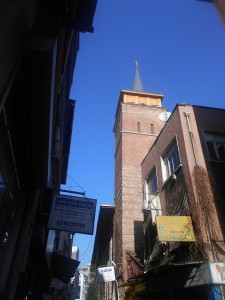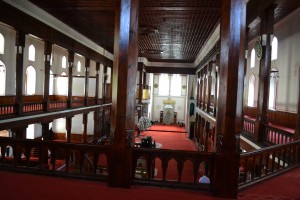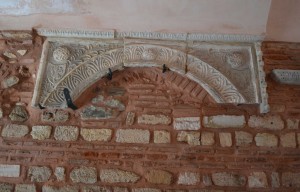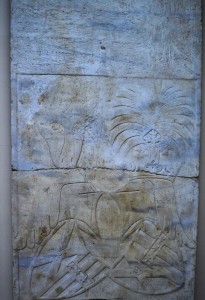This is something of a sanctuary among the maze of workshops and unwise attempts to get vans into places that they won’t go (41.024423,28.971183). There is a lovely courtyard with a şadırvan and seats in the shade. The bekçi is probably the most conscientious in Istanbul. It’s worth going in on a sunny spring morning when he has opened all of the windows and the place smells fresh and airy.
There are a few remains of a 6th century Byzantine chapel, probably dedicated to St Irene, including a column base that was revealed by excavations.This is possibly the one referred to by Procopius in his Buildings (page 65-67). If so, there might be a lot more to be excavated than has so far been hinted at.
A Latin Chapel to St Paul was built on the site in 1233, during the Latin occupation of Constantinople.
In 1307, the Byzantines were back in charge and Emperor Andronikus II Paleologos relegated the Dominican friars to the Galata district. There was already a Dominican monastery in the area. The current building, dating from 1325, is a long, rectangular Latin church in a rather pleasing Gothic style. It was dedicated to San Domenico, although even now people refer to it as the Church of St Paul. It is the only representative of this architectural movement in the city. It has a nice, tall belfry which has not been diminished by conversion into a minaret. It was restored in the early 20th century when the wooden galleries were added.
Mehmet II decided soon after the conquest that it would make a fine mosque, which it does. The Dominicans were shifted up the hill to the Priory of San Pietro which thereafter was dedicated to Peter and Paul. Towards the end of the 15th Century there was an influx of Muslims fleeing from the Inquisition in Spain. Beyazit II allocated this mosque for their use. The reference by teh locals to the new arrivals as Arabs is probably the origin of the name ‘Arap Camii’.
A persistent legend suggests that this was the first mosque in Istanbul, built during the Arab siege of 715. There is a shortage of evidence to support this, despite the apparently authoritative notices outside. It would appear to be part of the mythology conjured up in early Republican times to promulgate a new Turkish history that would lend itself to an inward-looking, protective nationalism.

Categories: Uncategorized | 1 Comment »





June 30th, 2014 at 10:16 am
[…] Arap Camii […]